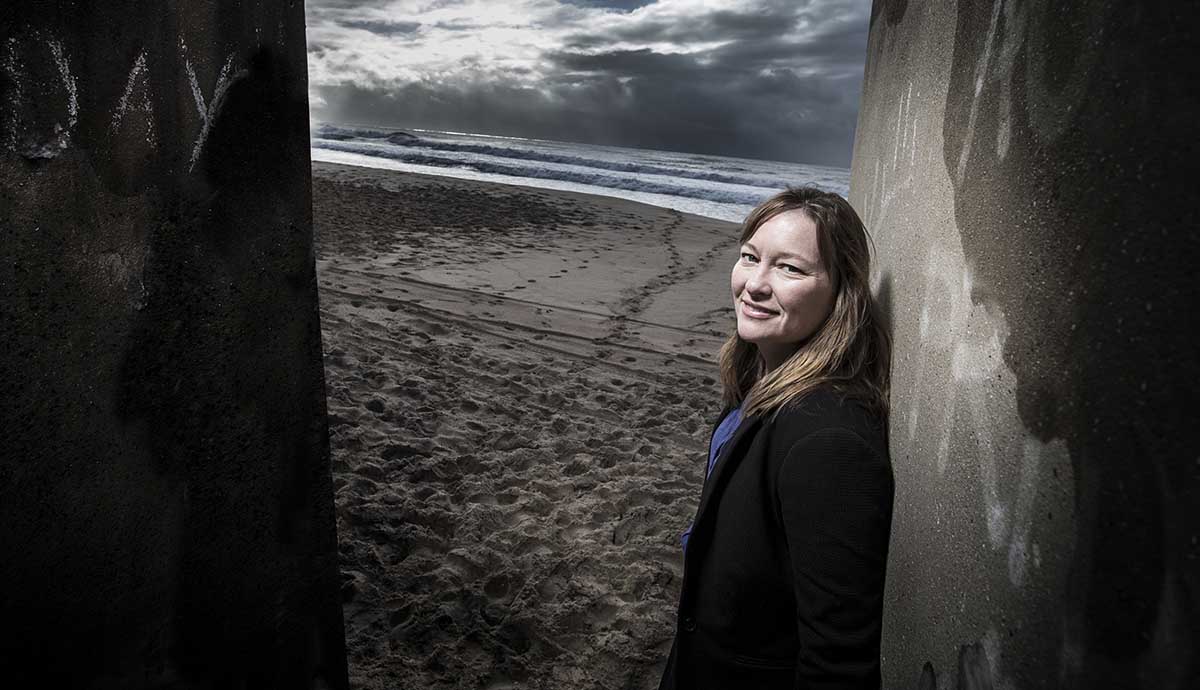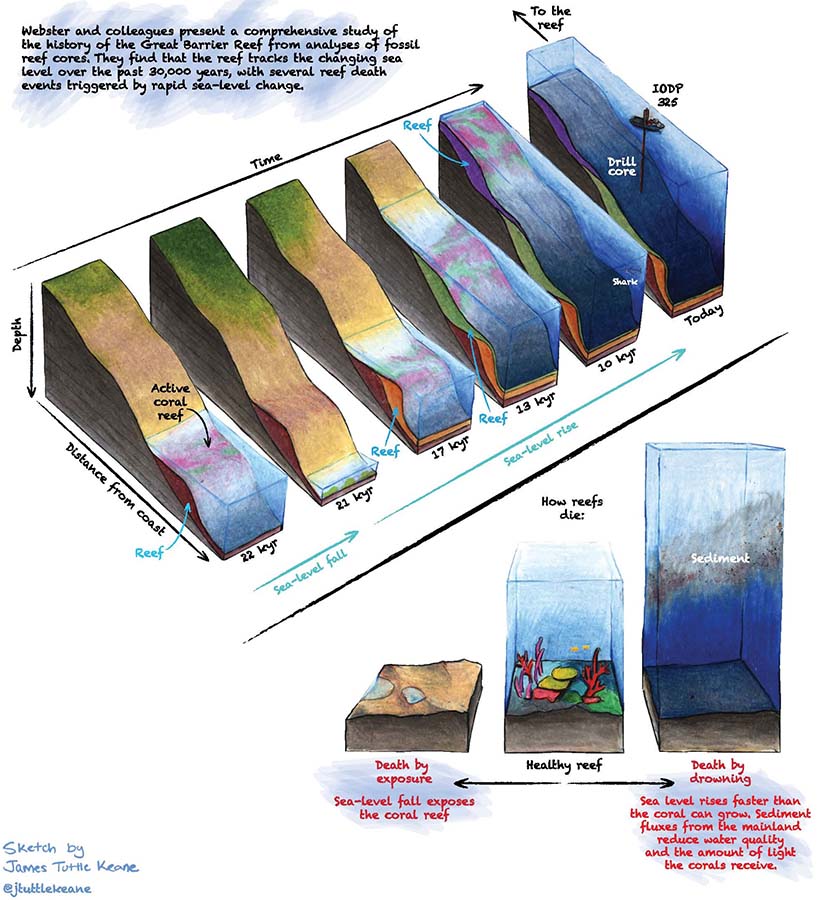May 29, 2018
Great Barrier Reef endured five death events in past 30,000 years
Reef more resilient to sea-level change but more vulnerable to sediment than previously thought
Over the past 30,000 years the Great Barrier Reef has endured five death events, largely induced by fluctuations in sea level, a 10-year study by an international team of researchers has shown. The study, published today (29 May) in Nature Geoscience, provides the first continuous record of the reef’s evolution over such a lengthy period.
The study involved 17 scientists from six countries, led by Associate Professor Jody Webster from the University of Sydney and including Associate Professor Helen McGregor, from the University of Wollongong (UOW).
While the study found the reef could adapt to some extent to changing sea levels, it also showed the reef was more vulnerable to poor water quality than previously thought. This is concerning as the Great Barrier Reef not only faces the challenge of rising sea temperatures and rising sea levels brought on by climate change, but is also challenged by increased sediment in the water due to land-clearing, farming and industrial practices.
The researchers drilled at 16 different sites on the reef and analysed the core samples. They found the reef had adapted to a changing environment by migrating seaward when sea levels fell, and then landward when sea levels rose again.
Two of the death events were caused by the sea level dropping and exposing the coral, and two were caused by sea levels rising and “drowning” the coral. The fifth and most recent death event, around 10,000 years ago (before the modern reef emerged around 9,000 years ago), appears to have been caused by a dramatic increase in sediment and consequent decline in water quality.
Professor McGregor, from UOW’s School of Earth and Environmental Sciences, said the study reveals just how dynamic the reef is.
“What this study does that nobody has done before is document in detail how the reef changed in response to sea level rises and rising temperatures,” Professor McGregor said.
“It documents which coral assemblages came and went – and the past reef water depths – and what the parallel sea level and temperature changes there were, which we’ve also been able to determine from the samples.
“We found that the reef comes and goes. When the sea level drops, the corals are exposed and the reef reforms further down slope where the sea level has fallen to. Then, as the sea level rises, it drowns and grows back up the slope. So there is this sort of back and forth.”
 "While the reef has recovered in the past, that process takes a while. It’s not like we can trash the reef and it will suddenly come back" – Associate Professor Helen McGregor
"While the reef has recovered in the past, that process takes a while. It’s not like we can trash the reef and it will suddenly come back" – Associate Professor Helen McGregor
An Australian Research Council Future Fellow and an expert in climate change, Professor McGregor’s role in the study was to analyse the cores to see what they revealed about past temperature changes.
“As well as being able to log the changes in sea level and the changes in coral communities, some of those coral species record temperature change in the chemical composition of the skeleton, and that’s what I specialise in,” she said.
“Also my role was to visualise the changes and help pull that information together, so putting the big picture together.”
The Great Barrier Reef’s capacity to migrate in response to sea-level change suggests it has been more resilient to sea-level and temperature fluctuations than previously thought – but there’s a catch. Professor McGregor cautioned that that reef’s ability to endure previous periods of climate changes did not necessarily mean it could survive present environmental challenges.
“The difference between the periods in the study and the present day is the rate of change – those past temperature changes occurred over much longer periods of time,” she said.
“In the past it was in the order of three-to-four degrees change over a period of about 10,000 years, whereas we’ve seen a temperature rise of almost one degree over the past 100 years.
“And while the reef has recovered in the past, that process takes a while. It’s not like we can trash the reef and it will suddenly come back – it takes time to re-establish itself.”
The study also showed the reef was sensitive to increases in sediment and poor water quality.
“When you’re stirring up the sediment the water becomes murky and not as much light gets through so the corals can’t grow – and that’s without considering any potential pollution factor from whatever is in the water.”
Professor McGregor said the biggest threats to the reef today were rising sea temperatures and sediment runoff.
“I would put sea-level rises as a long-term concern, the sediment input and temperature rises are what we really need to be worrying about immediately. We need to mitigate carbon dioxide emissions and look after water quality,” she said.
“From a scientific point of view and from looking historically into the records, these two things stand out. If you’re not increasing the carbon dioxide at the present rate then the temperatures are less likely to cross those thresholds for bleaching. If you improve the water quality and reduce the sediment runoff then the corals are able to grow.
“They’re not straightforward things to achieve, but that’s what we’ve got to aim for. These are remarkable ecosystems; to lose them is something we shouldn’t even contemplate. We should be doing everything we can to make sure that doesn’t happen.”
 The Great Barrier Reef adapted to past climate change by migrating seaward when sea levels fell, and then landward when sea levels rose again.
The Great Barrier Reef adapted to past climate change by migrating seaward when sea levels fell, and then landward when sea levels rose again.
ABOUT THE STUDY
‘Response of the Great Barrier Reef to sea level and environmental changes over the past 30,000 years’ by Jody M. Webster, Juan Carlos Braga, Marc Humblet, Donald C. Potts, Yasufumi Iryu, Yusuke Yokoyama, Kazuhiko Fujita, Raphael Bourillot, Tezer M. Esat, Stewart Fallon, William G. Thompson, Alexander L. Thomas, Hironobu Kan, Helen V. McGregor, Gustavo Hinestrosa, Stephen P. Obrochta and Bryan C. Lougheed, is published in Nature Geoscience.
The study was made possible through the support of the International Ocean Drilling Program and funded in part by ARC Discovery and LIEF grants.
:format(jpg)/prod01/channel_3/assets/live-migration/www/images/content/groups/public/web/media/documents/mm/uow247788.jpg)